Two Unusual Andean Tubers Delight in May: Oca and Añu
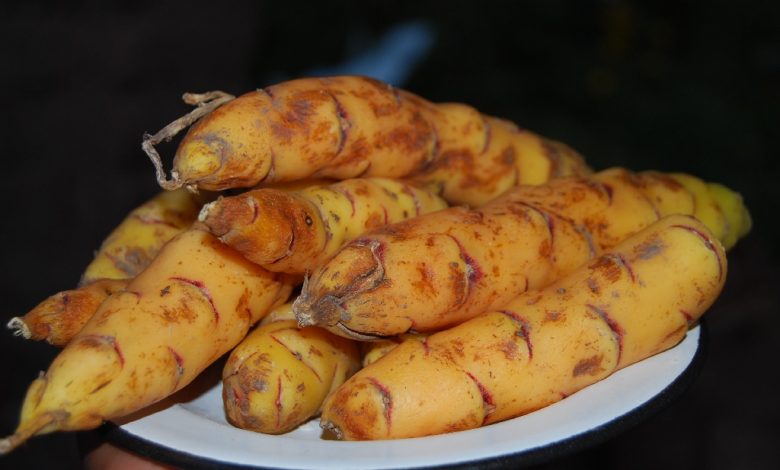
The Andes are the Eden of tubers. While potatoes are the best known, others are just now beginning to come to the attention of the outside world. One of these, a particularly delicious one of these, is the oca (oxalis tuberosum,) now being offered to gardeners in Europe and America.
In Cuzco oca and its companion añu, also called mashua, are just being harvested and appearing on plates throughout the city. These two tubers are not harvested at the same time, they are born together and they combine well on the plate, though they are from different species. Añu is a species of tropaeolum related to the nasturtium whose leaves and flowers are increasingly finding their way into the culinary world, while the oca is from the wood sorrel family.
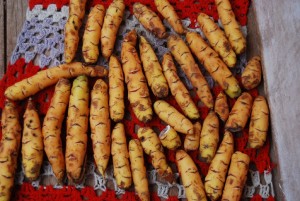
The oca is known for being quite colorful. When people are digging in the dirt at harvest time, this tuber appears as if born into the air in bright colors, white, pink, garnet, orange, and purple, though its initial flavor is bitter. When first brought from the ground, the añu is also bitter, though it has only a single solid color, yellow.
In both cases the bitterness disappears when they are left in the sunshine, to sunbathe (solearse) as the say in local Spanish. They both become quite sweet. Their only difference is that the añuis more starchy. To attain the sweetness they are left in the open sun from seven to nine days. They they become quite sweet.
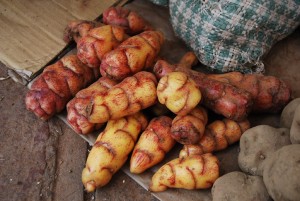
I remember how when we would walk through the markets, a good friend of mine on seeing the women selling boiled oca could not resist it. He had to taste it and said its flavor was as enchanting as bee honey.

Because of this sweetness. oca combines well with the añu, which is starchier. And both are often put together in Peruvian deserts such as mazamorra pudding, gelatin, and others according to the creativity of the cooks and chefs.
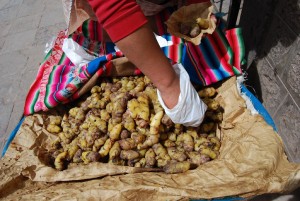
But their presence is not limited, of course. The continuously appear with more and more frequency in company with various main courses of the Peruvian kitchen.
They can be subjected to various cooking techniques, such as baking, boiling, or in pachamanca, a stone oven, or as huatia when they are baked long with potatoes in an improvised over of dirt clods. Huatia is commonly prepared in the month of June when the land is dry and Cuzco’s population likes to go outdoors to eat this delicious rustic dish in the company of their family and friends
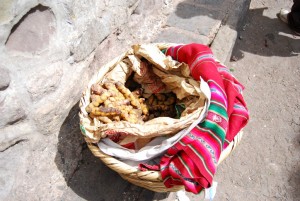
These ancestral foods, añu and oca, date from before the Incas and used to be cultivated in very large scale because of their nutritional value and agreeable flavor. They have continued to be cultivated, as a result, from one generation to another near the Imperial city of Cuzco.
Both Oca and Añu are tubers with a high content of fiber, when compared with the potato. They are also an important source of vitamins C and E that serves as an exfoliant for the skin as well as for the healing of superficial wounds. It also serves to bring down swelling from blows.

In Pisac they have the custom of processing the oca in the same way they make chuño. They freeze it overnight and then dry it during the day. Once dry they grind it to make a flour that can be used in deserts and other dishes It is known for its sweetness, especially when prepared in puddings (mazamorras).
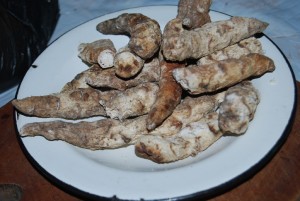
It is also used dried in soup. And in this dried form it is known in Pisac as khaya. One can make sweets with it by including cinnamon, cloves, molasses (chancaca) or if you wish to make it more nourishing, by adding milk. This flour and the sweets are found in the Sacred Valley, especially in the town of Pisac.
Beginning this month (May) and continuing through June, the city of Cuzco hosts vendors going through the streets offering baked oca and añu, along with sweet potato (camote) and bananas. During these two months the caseritas (vendors) will shout out “buy from me caserito, fresh oca hot from the oven, buy it hot.”

These items are sold only during the months of May and June in this way. The demand is strong and they are found in all the fairs and markets of our city of Cuzco.





Hello,
Please i want to buy tubers of tropaeolum tuberosum,pentaphylum,azureum.Can i to buy ?and where .There are on line shop?
Thank you
Dave’s Garden gives two places where you can purchase mashua, tropolaneum tuberosum, online. Sacred Succulents also offer them. On the others, I do not know.
Cheers,
David
P.S. If you just want the tubers, rather than growing them, they can be rather difficult to find outside of Peru and even there they are not generally grown commercially. You might wish to consult with a Peruvian grocer near you to see if his wholesaler can provide them for you.